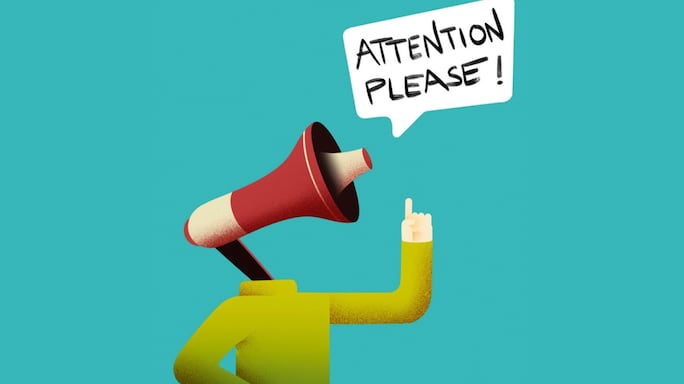- HOME
- /
- Culturescape
- /
- Book Extract
- /
Attention Please!
What information registers in our brains depends on what our attention allows in. And who regulates this filter? You do!
 Illustration by Siddhant Jumde
Illustration by Siddhant Jumde
What you register or experience is determined by what you pay attention to. Only the things we pay attention to seem real to us, whereas whatever we ignore—no matter how important it may be—seems to fade into insignificance. If you go to a shop looking for red shoes to match your red dress, your gaze will stop only at that colour and you will not notice other shoes, no matter how stylish they are.
WHAT IS ATTENTION?
Look around the room you are in. Ob-serve all the white things in the room: It may be the paint on the wall, clothes, curtains, the fan, switchboards, furniture. How many white things did you notice? Now, without checking, can you recall the blue things in the same room? Look again. You will notice that you missed many obvious blue things. Because your first task was to look for the white objects, you ignored the rest of the colours present around you. In spite of the visual stimulus, you did not allow it to register mentally.
That’s what attention does. It is like the beam of light from a torch in a dark room. You will be able to see only certain things in that light. The others remain invisible. Therefore, attention is the capacity to focus on one element or thing while ignoring all others.
WHAT DISTRACTS US?
Consider this scenario: A CEO receives an unexpected email from his marketing manager, asking for an appointment to speak about something important. His mind starts racing about what his manager is going to say. Is he going to ask for a raise? Is he going to resign? Does he have any complaints? All these worries lead to a number of mistakes in the report he is preparing.
There are many factors that take our attention away from a task at hand, resulting in mistakes. These factors can be external or internal stimuli. The factors mentioned in the above example are internal stimuli—mental or emotional distractions that divert our attention towards irrelevant matters, creating stress. Now, imagine you’re preparing for a presentation and are totally engrossed in it, but there is a loud and constant noise coming from a celebration next door. You immediately get distracted and upset, and lose focus. If your phone rings while you are driving, you take your eyes off the road to see who is calling. These are external factors that demand our immediate attention.
When you rapidly switch your focus from one thing to the next, you are slicing your attention. Imagine typing an email when a Facebook notification pops up. Even if you look at it only for a second before going back to the mail, that little bit of diversion is enough to cut your attention by half. When you try to do too many things at the same time, you are effectively slicing your attention into myriad pieces. If these instances of slicing pile up, or become a habit, it eventually starts affecting the way you perform in life. So choose who and what you pay attention to very carefully.
Here are a few exercises that will help you keep your attention on the task at hand for longer durations.
“I Am Here” While reading a book or listening to someone speak, we get distracted by the slightest sound or move‑ment, or our own thoughts. To bring our attention back, it helps to associate a phrase to it. For example, say “I am here” to yourself when your attention moves away. This will bring your focus back to the present moment and to your work. If your attention drifts off again, repeat the phrase.
No-Check Time Keep track of the number of times you check your phone in one hour. Fix a period of time—two or three hours—during which you will not check your phone or other gadgets. Don’t worry about missing out on important communication: People can always call you or someone in your family in case of an emergency.
Mindful Me Mindfulness means paying full attention to what is happening around you and what you are doing. When you get up in the morning, sit in a comfortable place and use your five senses to focus fully on your surroundings. Look around you and identify five things that were always there but you haven’t noticed in a long time. Next, concentrate on the sounds around you. What kinds of smells can you identify? Pay attention to the taste of tea, cof‑fee or milk you may be drinking. Is it sweet, bland, bitter? If mindfulness becomes a part of your daily routine, it can bring sanity to even the most chaotic situations.
The Spotlight We often get distracted while speaking to other people. To keep your attention from wandering, imagine a lit bulb over the head of the person you are speaking to. Even if you are talking to someone on the phone, visualize their face with a bulb over their head. This practice can improve your attention, as well as interactions and relationships with others.
Attentive Listening Listening is the most important part of communication, but also the most neglected one. As a rule, do not interrupt others while they are speaking. Acknowledge what they are saying and allow them to finish. This not only helps us focus better on the content of the conversation but also improves interpersonal connections.
Founders of the Dynamic Minds Group, Aditi Singhal and Sudhir Singhal are memory trainers, math educators, authors and motivational speakers.
Edited and excerpted with permission from How to Improve Your Concentration, published by Penguin Random House.






